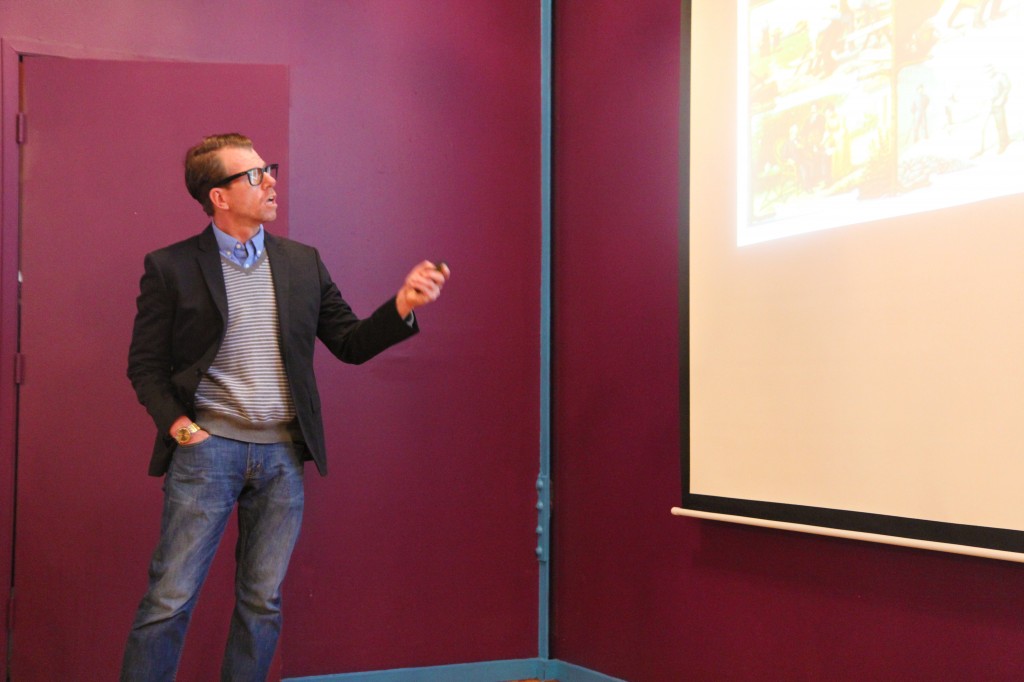
Where a child grows up may affect his or her achievements later in life. This trend was the topic of the Binghamton Community Lab’s monthly talk in the Violet Room of the Lost Dog Cafe on Tuesday.
Chris L. Gibson, professor in the sociology, criminology and law department at the University of Florida, lectured about the different possible factors that shape the emotional and mental growth of children. He said genetics and neighborhood conditions can play a role in molding a child’s thought processes and ability to work through emotions.
Gibson explained the correlation of poverty to different neighborhood factors. He used the results of a study done on over 80 neighborhoods in Chicago that tracked the development of 6,000 children to illustrate the factors related to the economic inequality in the poorest neighborhoods.
The impoverished areas had several similarities. All were predominantly populated by African-Americans, indicating racial segregation. They were also food deserts, meaning the neighborhoods were the farthest from grocery stores and places to buy healthy foods. The schools in these neighborhoods showed the lowest level of performance, and there were very high levels of violence.
David Currie, director of the Binghamton Regional Sustainability Coalition, spoke of the opportunity to connect the study in Chicago to neighborhoods here in Binghamton.
“Here we’re looking at Chicago, but how do those things play out in our neighborhood?” Currie asked. “What can we learn from [the study]?”
Gibson also described a study conducted by psychologists at the University of Southern California in which children between the ages of 7 and 12 were asked to draw their neighborhoods.
According to Gibson, those in low-disadvantage neighborhoods drew cheerful seasons with bright suns, neat houses with picket fences, clear roads and trees. Those in high-disadvantage neighborhoods drew scenes such as shootings and police chasing cars down streets.
Another study that Gibson discussed was done on secondary exposure to violence, or children who had witnessed violence in their neighborhoods. According to Gibson, children with high exposure to violence had more emotional problems, lowered academic performance, lower abilities to empathize with others, higher heart rates, irregular sleep patterns, increased alcohol and drug use and were more likely to become violent themselves.
However, Gibson pointed out that neighborhood factors were not enough to evaluate a child’s risk levels.
“The data [about neighborhoods] says nothing about how two kids from the same concentration of poverty and social ills can turn out very differently,” Gibson said. “What this requires is for us to study both variation in neighborhoods as well as variation in children.”
Gibson revealed the results of a study done by the Family and Community Health Study that followed 800 African-American families in Iowa and Georgia with children from age 12 to emerging adulthood. The study tried to answer the question of whether genetics could be at work in relation to neighborhood aggression in children. Eight-hundred children were tested for levels of genes that control emotion, including serotonin and dopamine.
Gibson explained the findings of the study.
“Kids with more of the risk alleles in the high-disadvantage neighborhood had higher and higher aggression,” Gibson said. “The genetic risk in the low-disadvantage neighborhoods didn’t affect aggression. This is an indication of how differences between children can have consequences for how they interpret their environment, which in turn has consequences for how the environment affects them.”
Gibson ended his talk by addressing the importance of community cooperation in protecting children from violence and keeping them on a safe path.
“You can think back about the neighborhoods you live in right now or as children and ask certain questions,” Gibson said. “Do people get along? Do people trust one another? Do people help one another out in a time of need? If something bad is happening in the neighborhood, are they willing to intervene, or are you willing to intervene?”
The Binghamton Community Lab is organized by the Binghamton Neighborhood Project, a collaboration between Binghamton University and community partners to understand and improve Binghamton’s quality of life.
Currie was enthusiastic about the results brought about by the Binghamton Community Lab.
“To have the opportunities presented by Binghamton Community Lab, by having people like [Dr. Gibson] come and share all of their knowledge, even in the short hour, how much can we absorb — that’s what’s incredible,” Currie said. “Whether it’s someone coming from the outside and teaching us about our own region, our own neighborhood or whether it’s someone on the inside coming to us and revealing things we didn’t see, that kind of learning foments change.”


